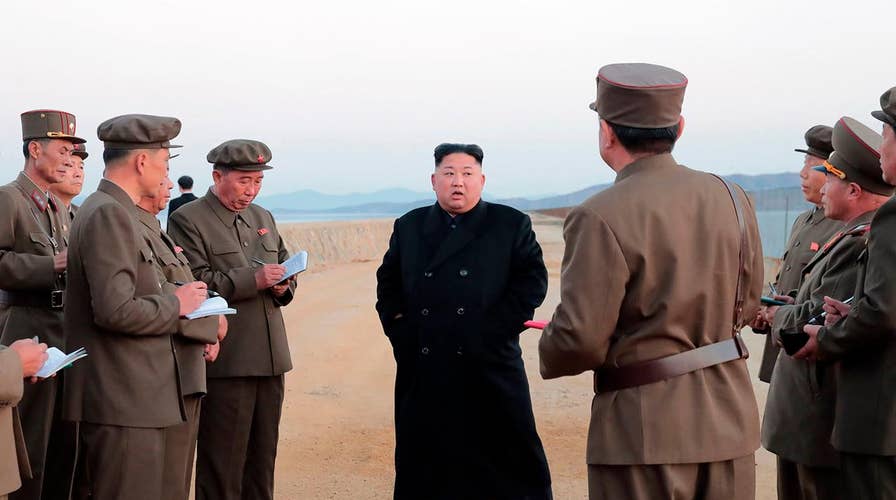North Korea says it has tested 'ultramodern tactical weapon'
State media release photo of Kim Jong Un inspecting the alleged test site; Greg Palkot details the report.
North Korea’s surprise announcement Friday that dictator Kim Jong Un has supervised the test of an unspecified “high-tech tactical weapon” means that a potential military confrontation between the U.S. and the North over nuclear weapons and missiles is once again a real and frightening possibility.
The announcement is a clear signal from Kim that he could begin testing much more powerful weapons – think long-range missiles that could hit the U.S. – whenever he wishes.
While we don’t know what the North Korean mystery weapon is, some experts who study the hermit kingdom believe it is probably some sort of new multiple-rocket launch system.
But this isn’t all the bad news that came out of North Korea recently. The New York Times reported that Pyongyang is expanding its nuclear weapons and missile arsenals.
Now, to be clear, the Kim regime never promised to stop building atomic bombs or advanced missiles. In fact, in a New Year’s Day address this year Kim said he would “mass produce” nuclear warheads and missiles.
The sad truth, once again, is that we find ourselves at an unfortunate fork in the road when it comes to the challenge of dealing with North Korea.
Despite a long lapse in missile testing from the North, a historic summit in June in Singapore between Kim and President Trump, and what can only be described as a game-changing détente between North and South Korea, Kim’s growing nuclear weapons and missile programs have not been halted or dismantled.
Those programs create the possibility of a military confrontation between the U.S. and North Korea that could spark a second Korean War.
To be completely fair, there are no innocent parties when it comes to who is to blame for the current impasse.
For its part, North Korea is demanding economic sanctions relief before it begins the process of getting rid of its nuclear weapons.
The U.S. is demanding final, fully verified, irreversible denuclearization of the North before any sanctions are lifted.
This can only mean one thing – both sides have the exact opposite positions of how to solve the crisis.
Once hostilities began they could rapidly escalate and lead to a war – and in the worst-case scenario this could become a nuclear war, killing millions of people.
Clearly, the path forward towards a compromise will not be an easy one to travel.
My worry was that we could stumble into a war with the North by accident. For example, say a North Korean test of a new class of missiles went terribly wrong, crashing into a populated area in South Korea or Japan, and sparked a military response.
Once hostilities began they could rapidly escalate and lead to a war – and in the worst-case scenario this could become a nuclear war, killing millions of people.
The good news is that President Trump can broker a way out of another crisis with North Korea. During the third inter-Korean summit in September, Kim offered to close his Yongbyon nuclear testing facility in exchange for what was called at the time “corresponding measures.”
Multiple senior South Korean officials close to their president have confirmed to me that this wording is Kim’s way of asking for a peace treaty ending the Korean War, which was halted with an armistice agreement in 1953. The armistice was supposed to bring a temporary halt to fighting until a peace treaty was signed – but that still hasn’t happened, 65 years later,
A peace treaty – in which the U.S. and our allies would be trading what amounts to a piece of paper for plutonium – would be good deal, in my view.
From there, while there are no guarantees, we could move along several tracks to try to secure a lasting peace on the Korean Peninsula.
The two Koreas have already begun moving toward a path to peace.
While he gets almost no credit, South Korea’s President Moon Jae-in has delivered what can only be described as a miracle by negotiating a deconfliction agreement that has set up a no-fly zone along the Demilitarized Zone dividing North and South Korea.
The deconfliction agreement includes the removal of landmines and guard posts separating the nations, along with the creation of new lines of communication between the South Korean and North Korean militaries that could be invaluable in a crisis.
This is an effort Washington should support with no reservations. The “Moon Miracle” is designed to lessen tensions between the Koreas in areas that have nothing to do with nuclear weapons. It focuses on the world’s most heavily armed border and is delivering results.
On top of this, we need to work to establish a roadmap with North Korea that provides the regime with clear rewards for steps it takes towards denuclearization.
If the North verifiably destroys all its nuclear weapons and long-range missiles, Washington should place on the table a massive scale-back of U.S. forces on the Korean Peninsula as a sweetener – and perhaps even offer to withdraw all U.S. forces from South Korea – to show how serious our intent is.
While many in Washington expect another showdown with North Korea, we have a clear, viable path forward to avoid a potential conflict.
If President Trump presses forward in the bold fashion he has proven he can, he might even get the Nobel Peace Prize that I and others have said he would deserve.
I will be rooting for him.





















